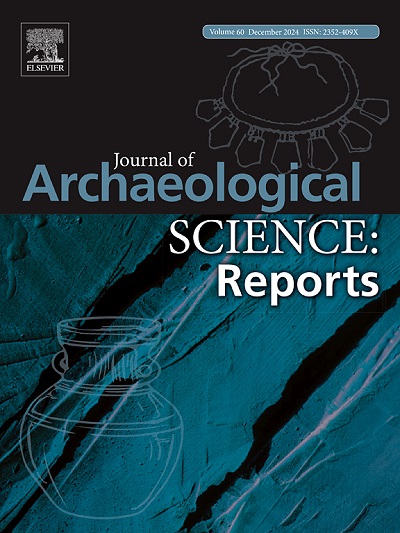第聂伯河上的玻璃流:霍尔蒂茨亚岛(乌克兰,扎波罗热)斯基泰背景下的玻璃珠考古研究
IF 1.5
2区 历史学
0 ARCHAEOLOGY
引用次数: 0
摘要
这项工作考虑了在公元前5世纪末至4世纪初的两个考古遗址中发现的21个玻璃珠/珠碎片,这些遗址位于乌克兰的霍尔蒂察国家保护区。这些珠子在该地区有许多相似之处,有些类型在该地区以外的不同考古文化遗址中也有相似之处。从考古学的角度来看,确定它们的成分是为了解决与早期铁器时代在hortytsia岛及其他地区的玻璃流通有关的问题。在khotytsia发现的所有玻璃都属于低镁玻璃类型(有两个可疑的例外),可以分为两个成分组,主要由TiO2浓度区分,两者都与铁器时代玻璃的成分框架组成,生产中心位于埃及和黎凡特。在hortytsia发现的玻璃的数据可以让我们深入了解样品中玻璃珠类型的成分相似性和差异性,表明这两种玻璃可以在同一种玻璃珠中互换使用,甚至在同一种玻璃珠中互换使用,这表明存在第二车间,可能靠近消费中心。这两种类型的玻璃都是在两个考古遗址,即坎法卡公墓和索乌廷斯克山堡发现的,证实了它们是由同一个人使用的。这里考虑的玻璃比之前分析过的来自其他考古遗址的玻璃更近,这些考古遗址可能与hortytsia有地理偶然性,因此这里获得的一组新的成分数据扩展了可用于追踪该地区玻璃演变的信息。本文章由计算机程序翻译,如有差异,请以英文原文为准。

Glass flow on the Dnipro River: An archaeometric study of glass beads from Scythian contexts on the island of Khortytsia (Zaporizhzhia, Ukraine)
This work considers a set of twenty-one glass beads/bead fragments found in two archaeological sites dating from the late 5th to the early 4th century BCE and located in the Khortytsia National Reserve in Zaporizhzhia (Ukraine). The beads have numerous analogues in the region, and some types have parallels in sites of different archaeological cultures also beyond this area. Their composition has been determined in order to address, from an archaeometric perspective, questions related to glass circulation during the Early Iron Age in the area of the Khortytsia island and beyond.
All of the glass found at Khortytsia belongs to the low-magnesia glass type (with two doubtful exceptions) and can be divided into two compositional groups, separated mainly by the TiO2 concentration, both of which are consisted with the compositional framework already traced for Iron Age glass, with production centres placed in Egypt and the Levant. The data for the glass found at Khortytsia allowed an insight into the compositional similarities and differences within the bead types included in the sample set, indicating that the two glasses were used interchangeably for the same bead type and even within the same bead, suggesting the existence of secondary workshops, possibly close to consumption centres. Both types of glass were found at both the archaeological sites, namely the cemetery of Kanfarka and the hillfort of Sovutynske, confirming that they were used by the same people.
The glass considered here is more recent than the previously analysed glass from other archaeological sites possibly related to Khortytsia by geographical contingency, therefore the new set of compositional data obtained here expands the information available to trace the evolution of the glass in the area.
求助全文
通过发布文献求助,成功后即可免费获取论文全文。
去求助
来源期刊

Journal of Archaeological Science-Reports
ARCHAEOLOGY-
CiteScore
3.10
自引率
12.50%
发文量
405
期刊介绍:
Journal of Archaeological Science: Reports is aimed at archaeologists and scientists engaged with the application of scientific techniques and methodologies to all areas of archaeology. The journal focuses on the results of the application of scientific methods to archaeological problems and debates. It will provide a forum for reviews and scientific debate of issues in scientific archaeology and their impact in the wider subject. Journal of Archaeological Science: Reports will publish papers of excellent archaeological science, with regional or wider interest. This will include case studies, reviews and short papers where an established scientific technique sheds light on archaeological questions and debates.
 求助内容:
求助内容: 应助结果提醒方式:
应助结果提醒方式:


